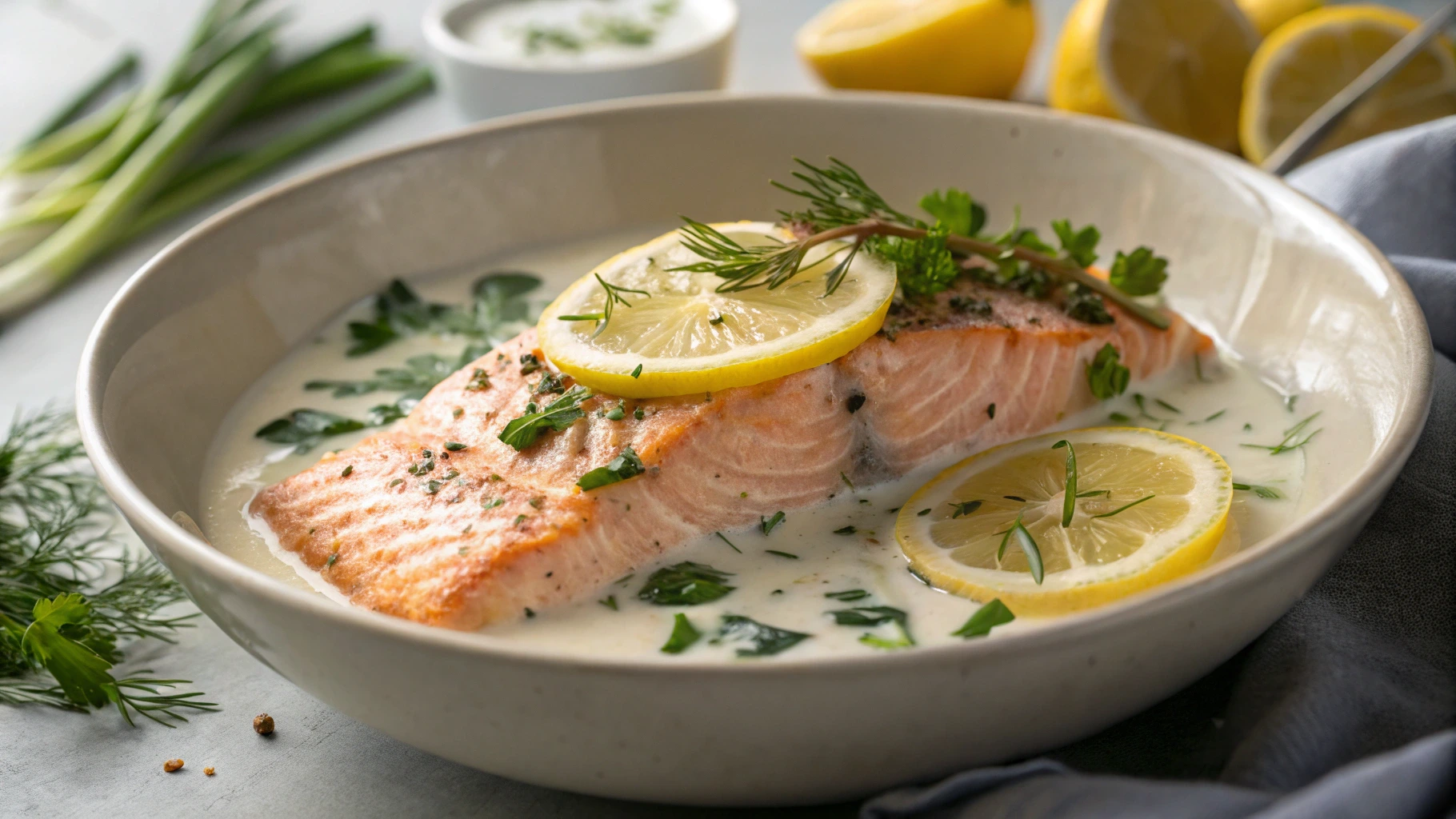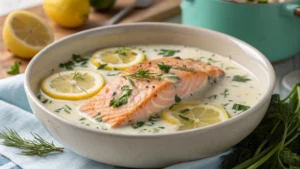Are you tired of the same bland dinners but feel too rushed to cook something gourmet each night? What if we told you that craving a quick, healthy dinner? Creamy Spring Salmon with Lemon And Herbs is rich, flavorful, and easy to make. Try this fresh, seasonal recipe today and experience the best of both worlds—in just under 30 minutes!
According to a recent survey by the Food Marketing Institute, 78% of Americans aim to eat healthier at home but struggle due to time constraints. This creamy spring salmon recipe is your answer: unpacked with omega-3 fatty acids, boosted by zesty lemon and fragrant herbs, and dressed in a velvety sauce—without the guilt or complexity.
Whether you’re cooking for one or feeding a growing household, this dish is a seasonal star that’s sure to become a favorite on rotation.
Ingredients List
This recipe centers around simple, fresh ingredients that come together to highlight the natural richness of salmon:
- 4 salmon fillets (about 6 oz each), skin off or on per preference
- 1 tablespoon olive oil
- 3 cloves garlic, minced
- 1 small shallot, finely chopped
- 1/2 cup low-sodium chicken or vegetable broth
- 1 cup heavy cream (substitute with coconut milk for dairy-free option)
- Juice and zest of 1 lemon
- 2 tablespoons Dijon mustard
- 1 teaspoon salt (adjust to taste)
- Fresh cracked black pepper
- 1 teaspoon fresh thyme leaves
- 2 tablespoons fresh dill, chopped
- 2 tablespoons flat-leaf parsley, chopped
- 2 cups baby spinach (optional, adds freshness and color)
🧄 Ingredient Tip: For a lighter version, swap heavy cream for Greek yogurt (just stir in at the end off-heat to avoid curdling).
Timing
Knowing the time commitment is key when planning mealtime. Here’s what to expect:
- Prep Time: 10 minutes
- Cook Time: 20 minutes
- Total Time: 30 minutes
⏱️ Fun Fact: This creamy salmon recipe is 20% quicker than traditional baked salmon dishes and even faster than ordering takeout!
Step-by-Step Instructions
Step 1: Season and Sear the Salmon
Pat the salmon fillets dry using paper towels. Generously season both sides with salt and pepper for a perfect golden crust. Heat olive oil in a non-stick skillet over medium-high heat. Add salmon skin-side down (if using) and sear for 3-4 minutes until crisp and golden. Flip and cook another 3-4 minutes. Remove and set aside.
💡 Pro Tip: Don’t overcrowd the pan! Searing in batches helps maintain that irresistible crust.
Step 2: Build the Aromatic Base
In the same pan, lower heat to medium. Add minced garlic and shallots. Sauté for 1-2 minutes until fragrant and translucent.
This step layers flavor into the sauce and enhances the salmon’s natural sweetness.
Step 3: Deglaze and Simmer
Pour in the broth to deglaze the pan, scraping up browned bits (hello, flavor!). Let it reduce slightly, then stir in lemon zest, lemon juice, and Dijon mustard. Simmer for 2-3 minutes to allow flavors to meld.
🍋 Flavor Hack: Adding lemon zest intensifies citrus aroma without increasing acidity.
Step 4: Add Cream and Herbs
Lower the heat and gently stir in the heavy cream. Add fresh thyme, dill, and parsley. Simmer on low for 5 minutes until sauce thickens slightly and herbs release their aroma.
🌿 Customization Tip: Add red pepper flakes if you like a subtle kick!
Step 5: Return Salmon & Serve
Place the seared salmon back into the pan, spoon sauce over each piece, and cook on low for 2-3 minutes to allow flavors to infuse. Toss in baby spinach at this stage if using—just until wilted.
Serve hot with your choice of grain or veggies. Voilà! Dinner perfection.
Nutritional Information
Here’s the approximate nutritional breakdown per serving (based on standard ingredients):
- Calories: 460
- Protein: 34g
- Carbohydrates: 4g
- Fat: 34g
- Saturated Fat: 18g
- Omega-3s: Over 2000mg per filet
- Fiber: 1g
- Sodium: 370mg (using low-sodium broth)
🩺 Did You Know? Wild salmon is among the top 10 anti-inflammatory foods, shown to improve heart health and cognitive function.
Healthier Alternatives for the Recipe
Looking to make it lighter or diet-specific without sacrificing flavor?
- Use Greek yogurt instead of cream (stir off-heat).
- Replace salmon with sustainably sourced trout for a leaner profile.
- Choose coconut cream for a dairy-free, paleo-friendly version.
- Add zucchini noodles or cauliflower rice to make it low-carb or keto-friendly.
- Make it Whole30 compliant by omitting Dijon mustard and dairy—focus on herbs and lemon for flavoring.
🥑 Personalization Tip: Adding avocado slices as a garnish boosts the healthy fat content and adds creaminess without extra dairy.
Serving Suggestions
Presentation matters—and so does side selection for a well-balanced meal.
Here are crowd-pleasing ideas:
- Serve over herbed quinoa or wild rice.
- Pair with roasted asparagus or garlic sautéed green beans.
- Create a salmon bowl with arugula, cucumbers, cherry tomatoes, and a drizzle of extra lemon-herb sauce.
- For brunch? Enjoy with poached eggs and sourdough toast.
🍷 Wine Pairing: A crisp Sauvignon Blanc or Pinot Grigio complements this dish beautifully!
Common Mistakes to Avoid
Even simple recipes can trip us up—don’t fall for these common mistakes:
- Overcooking the salmon: Use a food thermometer; salmon is done at 145°F (63°C).
- Skipping the lemon zest: It intensifies the citrus flavor without additional acid.
- Curdling the sauce: Always add yogurt off-heat to avoid separation.
- Using dried herbs only: Fresh herbs provide brightness seasonal recipes need.
🎯 Data Insight: According to Cook’s Illustrated, over 50% of home cooks overcook their salmon—so mastering this recipe means joining the culinary elite!
Storing Tips for the Recipe
Salmon is best enjoyed fresh, but leftovers can still impress with proper storage.
- Refrigerate in an airtight container for up to 3 days.
- Reheat gently in a covered skillet over low heat—add a splash of broth or water.
- Want to prep ahead? Make the lemon-herb cream sauce separately and refrigerate for up to 4 days. Simply reheat and add seared fish when ready to serve.
🧊 Freezing Tip: Freeze only the cooked salmon, without creamy sauce, for best texture up to 2 months. Add fresh sauce after thawing for optimal results.
Conclusion
In just five flavorful steps, you’ve mastered an elegant, seasonal dish that’s as nourishing as it is simple. Craving a quick, healthy dinner? Creamy Spring Salmon with Lemon And Herbs is rich, flavorful, and easy to make. Try this fresh, seasonal recipe today—and bring gourmet ease to your kitchen any night of the week.
Ready to elevate your spring dinner game? Whip up this recipe tonight, drop a comment with your personalized twist, and check out our related posts like “10-Minute Garlic-Lemon Shrimp” or “Easy Dill-Crusted Cod.”
🍽️ Hungry for more smart dinner ideas? Subscribe to our newsletter for weekly recipes that are fast, fresh, and full of flavor.
FAQs
Q: Can I use frozen salmon for this recipe?
A: Yes! Just ensure the salmon is fully thawed and patted dry before searing to achieve that delicious golden crust.
Q: Is Greek yogurt a good substitute for heavy cream?
A: Definitely—but add it off the heat to prevent curdling. It adds tang and cuts fat content.
Q: What herbs can I use if I don’t have dill?
A: Fresh basil or tarragon make excellent alternatives—each brings its own unique flair to the creamy sauce.
Q: How do I know if my salmon is cooked perfectly?
A: Use a thermometer (look for 145°F), or check that the center flakes easily with a fork and is opaque throughout.
Q: Can this dish be made ahead for meal prep?
A: Yes. Cook the salmon and refrigerate separately from the sauce. Combine and heat before serving for best results.
Q: Does the sauce freeze well?
A: Cream-based sauces don’t freeze well and tend to separate—but you can freeze the cooked salmon and prepare sauce fresh.








